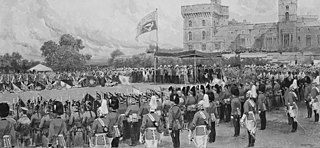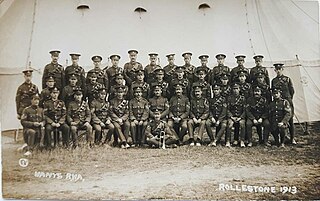Related Research Articles
The Australian Mounted Division originally formed as the Imperial Mounted Division in January 1917, was a mounted infantry, light horse and yeomanry division. The division was formed in Egypt, and along with the Anzac Mounted Division formed part of Desert Column, Egyptian Expeditionary Force in World War I. The division was originally made up of the Australian 3rd Light Horse Brigade, the reconstituted 4th Light Horse Brigade, and two British yeomanry brigades; the 5th Mounted Brigade and 6th Mounted Brigade.
The 2nd Mounted Division was a yeomanry division that served in the First World War. At the outbreak of war it was assigned to defence of the Norfolk coast. In March 1915 it formed a 2nd Line duplicate of itself, the 2/2nd Mounted Division. Leaving the 2/2nd on coastal defence, it then fought at Gallipoli from April to December 1915, under the command of Major General William Peyton, before being disbanded in January 1916.

The Territorial Force was a part-time volunteer component of the British Army, created in 1908 to augment British land forces without resorting to conscription. The new organisation consolidated the 19th-century Volunteer Force and yeomanry into a unified auxiliary, commanded by the War Office and administered by local County Territorial Associations. The Territorial Force was designed to reinforce the regular army in expeditionary operations abroad, but because of political opposition it was assigned to home defence. Members were liable for service anywhere in the UK and could not be compelled to serve overseas. In the first two months of the First World War, territorials volunteered for foreign service in significant numbers, allowing territorial units to be deployed abroad. They saw their first action on the Western Front during the initial German offensive of 1914, and the force filled the gap between the near destruction of the regular army that year and the arrival of the New Army in 1915. Territorial units were deployed to Gallipoli in 1915 and, following the failure of that campaign, provided the bulk of the British contribution to allied forces in the Sinai and Palestine Campaign. By the war's end, the Territorial Force had fielded twenty-three infantry divisions and two mounted divisions on foreign soil. It was demobilised after the war and reconstituted in 1921 as the Territorial Army.
The 1st Mounted Division was a Yeomanry Division of the British Army active during World War I. It was formed in August 1914 for the home defence of the United Kingdom from four existing mounted brigades of the Territorial Force, each of three regiments of Yeomanry. The divisional order of battle changed often, as the 1st Line brigades left for service overseas and were replaced by 2nd Line formations. It was converted to the 1st Cyclist Division in July 1916, and was broken up in November 1916 without being involved in active service. It remained in East Anglia throughout its existence.

The Royal Buckinghamshire Yeomanry is an Operational Hygiene Squadron of the Royal Logistic Corps, originally formed as cavalry in 1794, and has also served in artillery and signals roles. The lineage is continued by 710 Operational Hygiene Squadron, Royal Logistic Corps.
The 2nd South Midland Mounted Brigade was a yeomanry brigade of the British Army, formed as part of the Territorial Force in 1908.
The North Midland Mounted Brigade was a yeomanry brigade of the British Army, formed as part of the Territorial Force in 1908.
The South Wales Mounted Brigade was a formation of the Territorial Force of the British Army, organised in 1908. After home defence service, it was posted to Egypt, where it was absorbed into the 4th Dismounted Brigade in March 1916.
The West Riding Royal Horse Artillery was a Territorial Force Royal Horse Artillery battery that was formed in the West Riding of Yorkshire in 1908. It saw active service as field artillery with 52nd (Lowland) Division in Egypt during the First World War before being broken up at the end of 1916. Post-war, it was reconstituted as a Royal Field Artillery battery.

The Hampshire Royal Horse Artillery was a Territorial Force Royal Horse Artillery battery that was formed in Hampshire in 1909. It saw active service during the First World War in Egypt and Palestine from 1916 to 1918, initially as field artillery with 52nd (Lowland) Division before being converted back to horse artillery and serving with the Yeomanry Mounted Division and 1st Mounted / 4th Cavalry Division. A second line battery, 2/1st Hampshire RHA, served on the Western Front in 1917 and 1918 as part of an Army Field Artillery Brigade. Post-war, it was reconstituted as a Royal Field Artillery battery.
The Essex Royal Horse Artillery was a Territorial Force Royal Horse Artillery battery that was formed in Essex in 1908. It saw active service during the First World War in Egypt and Palestine from 1916 to 1918, initially as field artillery with 52nd (Lowland) Division before being converted back to horse artillery and serving with the 2nd Mounted / 5th Cavalry Division. A second line battery, 2/1st Essex RHA, served on the Western Front in 1917 and 1918 as part of an Army Field Artillery Brigade.
The Glamorganshire Royal Horse Artillery was a Territorial Force Royal Horse Artillery battery that was formed in Glamorganshire in 1908. It saw active service during the First World War on the Western Front in 1917 and 1918 as part of an Army Field Artillery Brigade. A second line battery, 2/1st Glamorganshire RHA, served in England and Ireland before being broken up in January 1917. Glamorganshire RHA was not reconstituted in the post-war Territorial Force.
B Battery, Honourable Artillery Company was a horse artillery battery that was formed from the Field Artillery, HAC in 1899. It transferred to the Territorial Force in 1908 as artillery support for the South Eastern Mounted Brigade.
The Inverness-shire Royal Horse Artillery was a Territorial Force Royal Horse Artillery battery that was formed in Inverness-shire in 1908. It saw active service during the First World War in the Sinai and Palestine Campaign with the ANZAC Mounted Division from 1916 to 1918. A second line battery, 2/1st Inverness-shire RHA, served in the United Kingdom throughout the war. It was disembodied after the end of the war and was reconstituted as a Royal Field Artillery battery in 1920.

The Leicestershire Royal Horse Artillery was a Territorial Force Royal Horse Artillery battery that was formed in Leicestershire in 1908. It saw active service during the First World War in Egypt and Palestine from 1916 to 1918, initially with ANZAC Mounted Division before joining the Yeomanry Mounted Division and 1st Mounted / 4th Cavalry Division. A second line battery, 2/1st Leicestershire RHA, served on the Western Front with the 63rd Division from 1916 to 1918. Post-war, it was reconstituted as a Royal Field Artillery battery.
The Shropshire Royal Horse Artillery was a Territorial Force Royal Horse Artillery battery that was formed in Shropshire in 1908 from the Shropshire Battery of the 1st Shropshire and Staffordshire Artillery Volunteers, Royal Garrison Artillery of the Volunteer Force. It saw active service during the First World War on the Western Front in 1917 and 1918 as part of an Army Field Artillery Brigade. A second line battery, 2/1st Shropshire RHA, also served on the Western Front in 1917 and 1918 as part of another Army Field Artillery Brigade. It was reconstituted post-war as a medium artillery battery and served as such in the Second World War.
The Warwickshire Royal Horse Artillery was a Territorial Force Royal Horse Artillery battery that was formed in Warwickshire in 1908. It was the first Territorial Force artillery unit to go overseas on active service, spending the whole of the First World War on the Western Front, mostly with 1st Cavalry Division and 29th Division. A second line battery, 2/1st Warwickshire RHA, also served on the Western Front in 1917 and 1918 as part of an Army Field Artillery Brigade. Post-war it was reconstituted as a Royal Field Artillery battery.

The Nottinghamshire Royal Horse Artillery was a Territorial Force Royal Horse Artillery battery that was formed in Nottinghamshire in 1908. It saw active service during the First World War in the Middle East – in the Senussi Campaign and the Sinai and Palestine Campaign – from 1915 to 1918. A second line battery, 2/1st Nottinghamshire RHA, served in the Mesopotamian Campaign in 1917 and 1918 as a Field Artillery battery. Post-war, it was reconstituted as a Royal Field Artillery battery.
The 1st North Riding Artillery Volunteers was a part-time unit formed in the North Riding of Yorkshire in 1860 in response to an invasion scare. The unit later became part of the Territorial Force and served on the Western Front during World War I, while their successors served as anti-aircraft gunners in World War II.
The British home army in the First World War served the dual purpose of defending the country against invasion and training reinforcements for the army overseas. Initial responsibility for defending the nation lay with the Territorial Force, a part-time auxiliary designed in 1908 as a means of expanding the army in a major foreign conflict but, as a result of political compromise, implemented as a home defence army. It was supported in this role by 42,000 regular army troops, primarily belonging to the Royal Garrison Artillery and the Royal Engineers. The 14 infantry divisions and 14 mounted brigades of the Territorial Force were mainly allocated either to the Local Force, stationed near the coast and tasked with disrupting an invasion at the point of landing, or the Central Force, a mobile element tasked with defeating the invading force as it marched on London. The Local Force was augmented by units of the Special Reserve and Extra Reserve, which were the third battalions of the regular army line infantry regiments established to recruit and train replacements for their regiments' two combat battalions. The home army was also largely responsible for guarding vulnerable points, such as the communications infrastructure, rail network and munitions works.
References
- ↑ Beckett 2011 pp. 213–217 & 230
- ↑ Becket 2008 pp. 54, 57 & 79
- ↑ Mitchinson pp. 59, 62 & 204
- ↑ Beckett 2004 p. 132
- ↑ Becke 2A pp. 35–41
- ↑ Becke 2B pp. 67–74
- ↑ Becke 2A pp. 43–48
- ↑ Becke 2A pp. 55–60
- ↑ Becke 2A pp. 49–54
- ↑ Becke 2B pp. 75–82
- ↑ Becke 2A pp. 61–67
- ↑ Becke 2B pp. 17–23
- ↑ Becke 2A pp. 69–75
- ↑ Becke 2B pp. 25–32
- ↑ Becke 2A pp. 77–834
- ↑ Becke 2B pp. 33–39
- ↑ Becke 2A pp. 85–91
- ↑ Becke 2B pp. 41–48
- ↑ Becke 2A pp. 93–100
- ↑ Becke 2B pp. 49–54
- ↑ Becke 2A pp. 101–107
- ↑ Becke 2B pp. 55–59
- ↑ Becke 2A pp. 109–115
- ↑ Becke 2B pp. 61–65
- ↑ Becke 2A pp. 117–123
- ↑ Becke 2B pp. 83–90
- ↑ Becke 2A pp. 125–131
- ↑ Becke 2B pp. 91–98
- ↑ Becke 2A pp. 133–139
- ↑ Becke 2B pp. 1–7
- ↑ Becke 2A pp. 141–147
- ↑ Becke 2B pp. 9–15
- ↑ Westlake pp. 14–15
- ↑ Becke 2A p. 7
- ↑ Becke 2A pp. 16–17
- ↑ Becke 2A pp. 25–26
- ↑ Becke 2A p. 30
- ↑ Becke 2A p. 34
- ↑ Becke 2A pp. 121–122
- ↑ Becke 2B pp. 101–105
- ↑ Becke 2B pp. 129–130